Accounting for Management Decisions 1: Turnkey Creek Wines Audit Plan
VerifiedAdded on 2023/06/05
|13
|4034
|435
Report
AI Summary
This report presents an audit plan for Turnkey Creek Wines (TCW), a major Australian client of Miller Yates Howarth (MYH). It details potential audit risks identified through ratio analysis (including return on investment, return on assets, receivable and inventory days, and marketing expense ratios) and assesses the effectiveness of TCW's internal controls, particularly concerning purchases and vendor payments. The report highlights weaknesses in the internal control system and provides justifications for these assessments. The analysis covers TCW's diverse business operations, including wine production, beef cattle production, and investments, while considering external factors like changing climate conditions. The assessment includes recommendations for improving internal control procedures to mitigate identified risks.

Accounting for
Management
Decisions
Management
Decisions
Paraphrase This Document
Need a fresh take? Get an instant paraphrase of this document with our AI Paraphraser
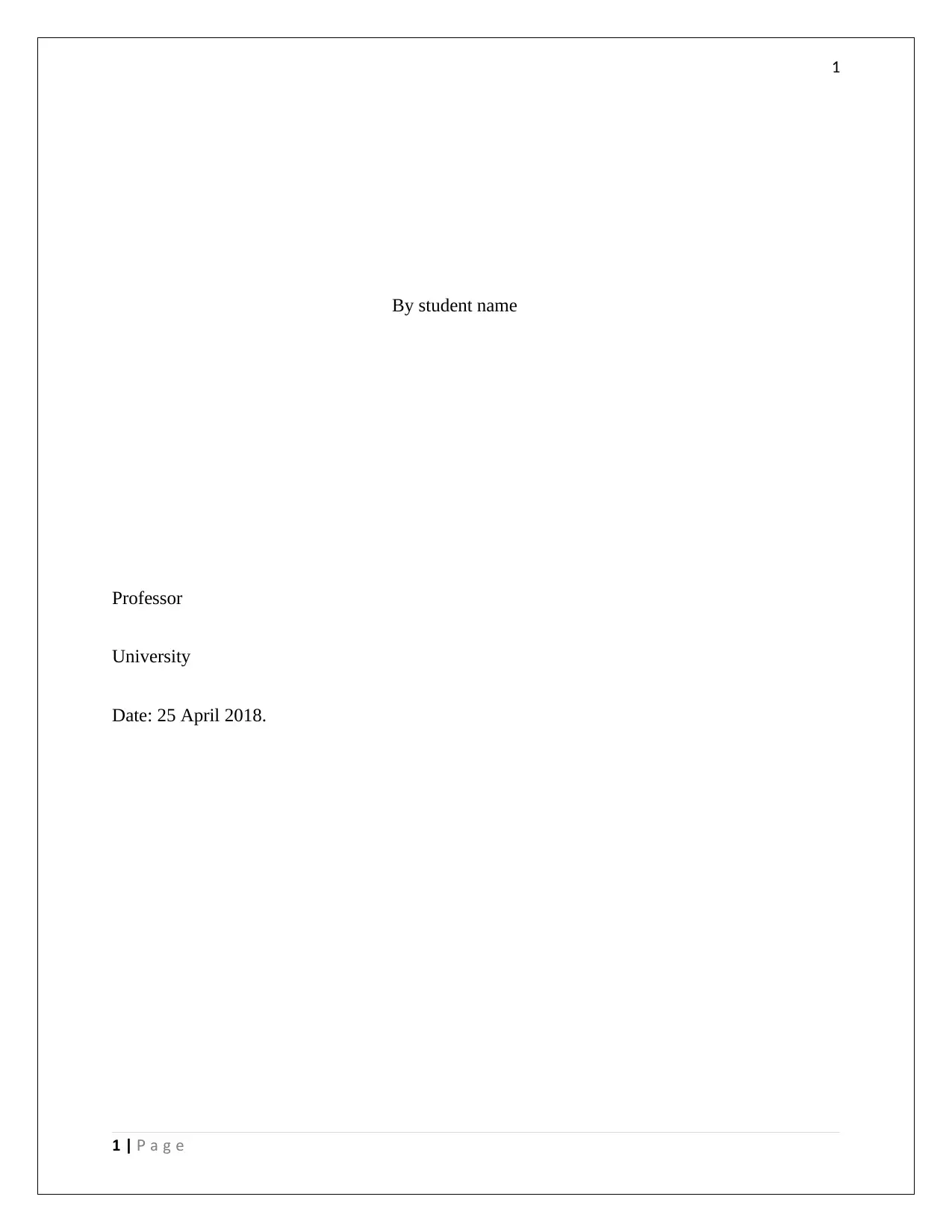
1
By student name
Professor
University
Date: 25 April 2018.
1 | a g eP
By student name
Professor
University
Date: 25 April 2018.
1 | a g eP
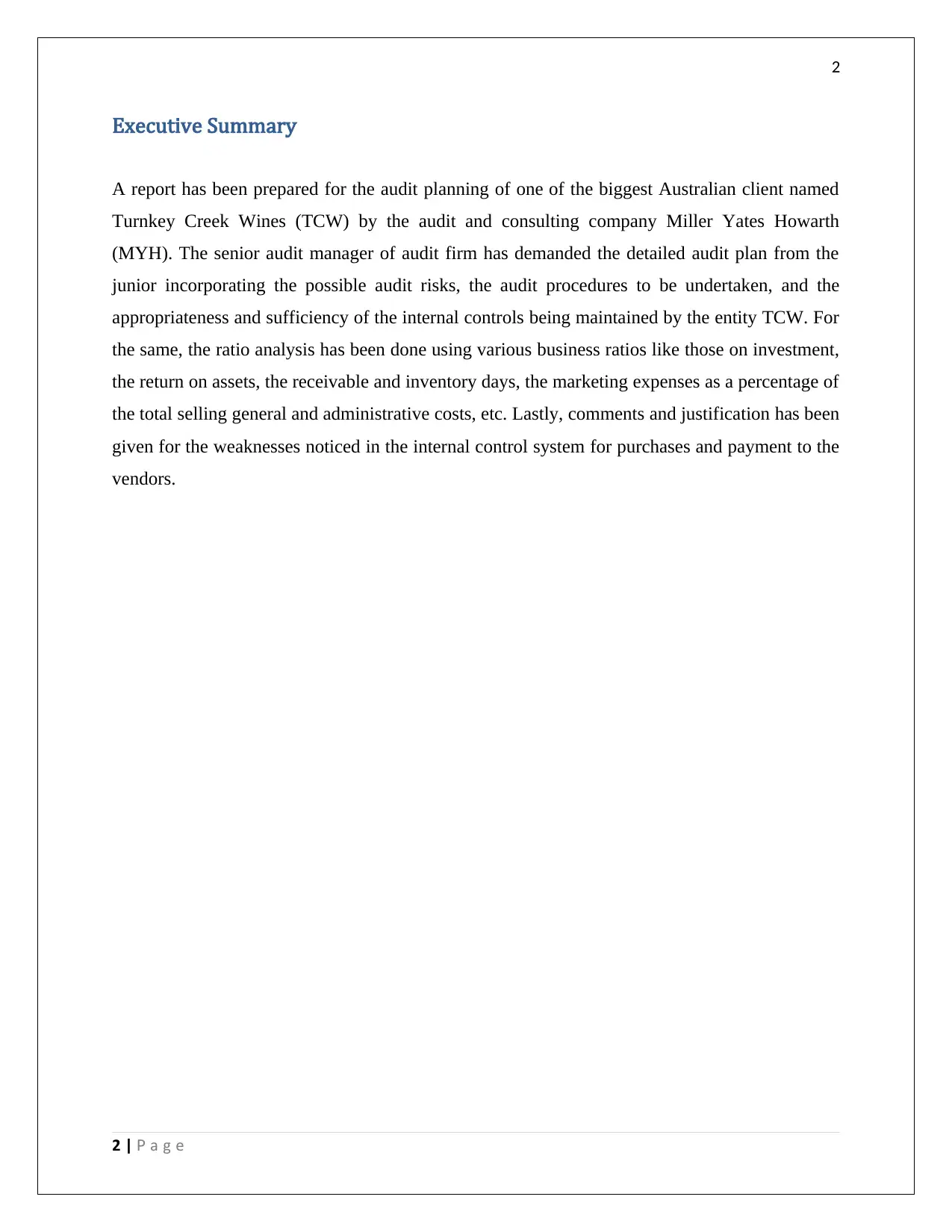
2
Executive Summary
A report has been prepared for the audit planning of one of the biggest Australian client named
Turnkey Creek Wines (TCW) by the audit and consulting company Miller Yates Howarth
(MYH). The senior audit manager of audit firm has demanded the detailed audit plan from the
junior incorporating the possible audit risks, the audit procedures to be undertaken, and the
appropriateness and sufficiency of the internal controls being maintained by the entity TCW. For
the same, the ratio analysis has been done using various business ratios like those on investment,
the return on assets, the receivable and inventory days, the marketing expenses as a percentage of
the total selling general and administrative costs, etc. Lastly, comments and justification has been
given for the weaknesses noticed in the internal control system for purchases and payment to the
vendors.
2 | a g eP
Executive Summary
A report has been prepared for the audit planning of one of the biggest Australian client named
Turnkey Creek Wines (TCW) by the audit and consulting company Miller Yates Howarth
(MYH). The senior audit manager of audit firm has demanded the detailed audit plan from the
junior incorporating the possible audit risks, the audit procedures to be undertaken, and the
appropriateness and sufficiency of the internal controls being maintained by the entity TCW. For
the same, the ratio analysis has been done using various business ratios like those on investment,
the return on assets, the receivable and inventory days, the marketing expenses as a percentage of
the total selling general and administrative costs, etc. Lastly, comments and justification has been
given for the weaknesses noticed in the internal control system for purchases and payment to the
vendors.
2 | a g eP
⊘ This is a preview!⊘
Do you want full access?
Subscribe today to unlock all pages.

Trusted by 1+ million students worldwide
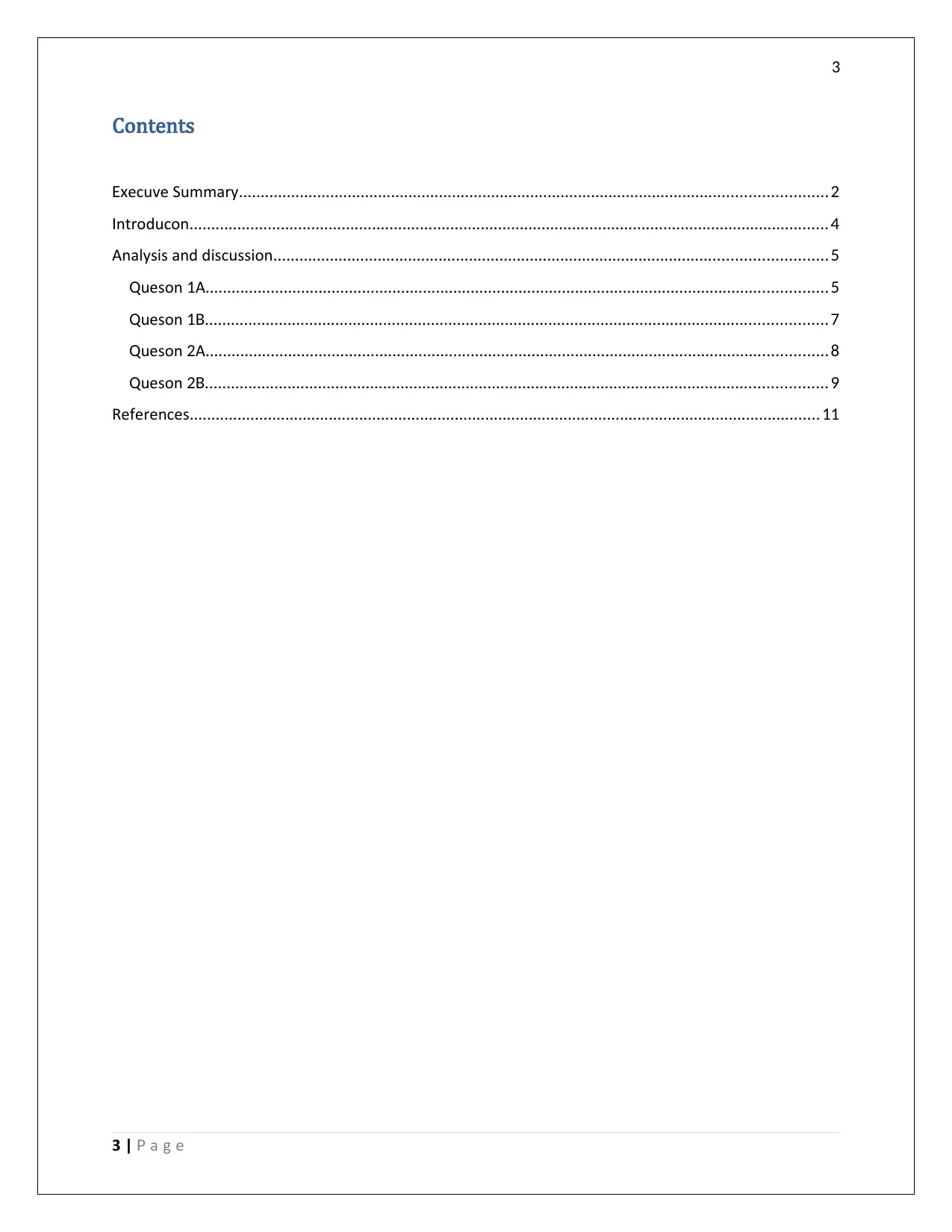
3
Contents
ecutive SummaryEx .......................................................................................................................................2
ntroductionI ...................................................................................................................................................4
Analysis and discussion...............................................................................................................................5
uestion AQ 1 ...............................................................................................................................................5
uestionQ 1B...............................................................................................................................................7
uestion AQ 2 ...............................................................................................................................................8
uestionQ 2B...............................................................................................................................................9
References.................................................................................................................................................11
3 | a g eP
Contents
ecutive SummaryEx .......................................................................................................................................2
ntroductionI ...................................................................................................................................................4
Analysis and discussion...............................................................................................................................5
uestion AQ 1 ...............................................................................................................................................5
uestionQ 1B...............................................................................................................................................7
uestion AQ 2 ...............................................................................................................................................8
uestionQ 2B...............................................................................................................................................9
References.................................................................................................................................................11
3 | a g eP
Paraphrase This Document
Need a fresh take? Get an instant paraphrase of this document with our AI Paraphraser
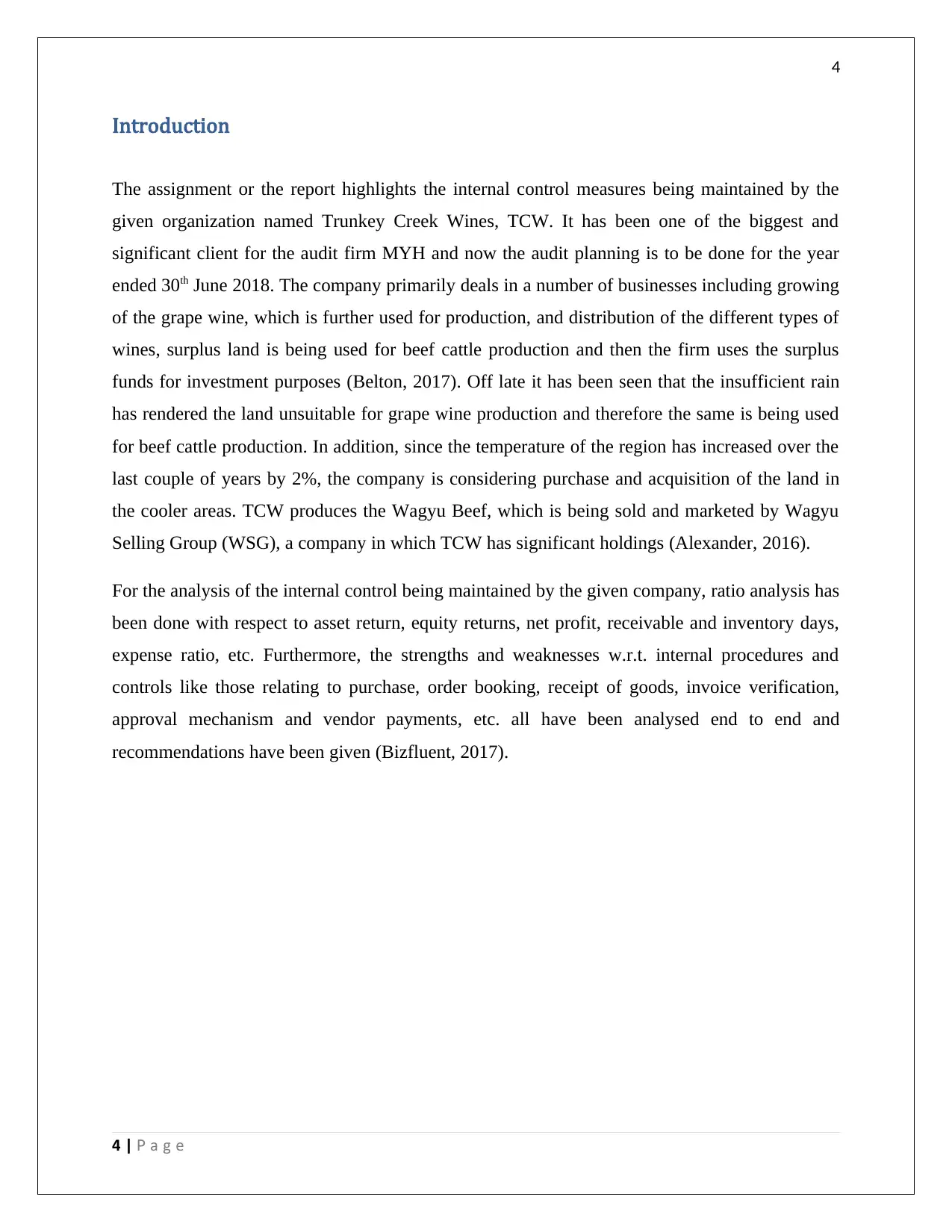
4
Introduction
The assignment or the report highlights the internal control measures being maintained by the
given organization named Trunkey Creek Wines, TCW. It has been one of the biggest and
significant client for the audit firm MYH and now the audit planning is to be done for the year
ended 30th June 2018. The company primarily deals in a number of businesses including growing
of the grape wine, which is further used for production, and distribution of the different types of
wines, surplus land is being used for beef cattle production and then the firm uses the surplus
funds for investment purposes (Belton, 2017). Off late it has been seen that the insufficient rain
has rendered the land unsuitable for grape wine production and therefore the same is being used
for beef cattle production. In addition, since the temperature of the region has increased over the
last couple of years by 2%, the company is considering purchase and acquisition of the land in
the cooler areas. TCW produces the Wagyu Beef, which is being sold and marketed by Wagyu
Selling Group (WSG), a company in which TCW has significant holdings (Alexander, 2016).
For the analysis of the internal control being maintained by the given company, ratio analysis has
been done with respect to asset return, equity returns, net profit, receivable and inventory days,
expense ratio, etc. Furthermore, the strengths and weaknesses w.r.t. internal procedures and
controls like those relating to purchase, order booking, receipt of goods, invoice verification,
approval mechanism and vendor payments, etc. all have been analysed end to end and
recommendations have been given (Bizfluent, 2017).
4 | a g eP
Introduction
The assignment or the report highlights the internal control measures being maintained by the
given organization named Trunkey Creek Wines, TCW. It has been one of the biggest and
significant client for the audit firm MYH and now the audit planning is to be done for the year
ended 30th June 2018. The company primarily deals in a number of businesses including growing
of the grape wine, which is further used for production, and distribution of the different types of
wines, surplus land is being used for beef cattle production and then the firm uses the surplus
funds for investment purposes (Belton, 2017). Off late it has been seen that the insufficient rain
has rendered the land unsuitable for grape wine production and therefore the same is being used
for beef cattle production. In addition, since the temperature of the region has increased over the
last couple of years by 2%, the company is considering purchase and acquisition of the land in
the cooler areas. TCW produces the Wagyu Beef, which is being sold and marketed by Wagyu
Selling Group (WSG), a company in which TCW has significant holdings (Alexander, 2016).
For the analysis of the internal control being maintained by the given company, ratio analysis has
been done with respect to asset return, equity returns, net profit, receivable and inventory days,
expense ratio, etc. Furthermore, the strengths and weaknesses w.r.t. internal procedures and
controls like those relating to purchase, order booking, receipt of goods, invoice verification,
approval mechanism and vendor payments, etc. all have been analysed end to end and
recommendations have been given (Bizfluent, 2017).
4 | a g eP
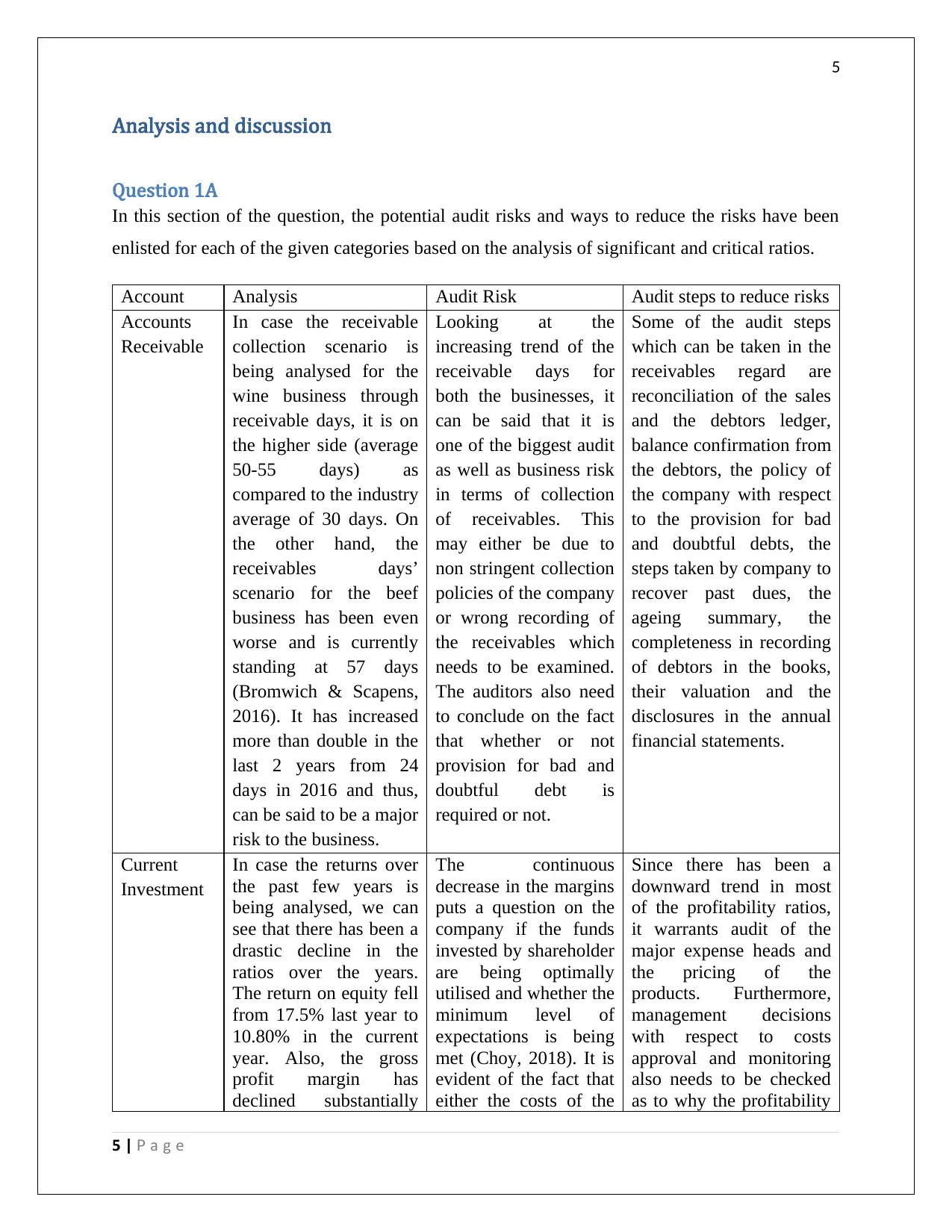
5
Analysis and discussion
Question 1A
In this section of the question, the potential audit risks and ways to reduce the risks have been
enlisted for each of the given categories based on the analysis of significant and critical ratios.
Account Analysis Audit Risk Audit steps to reduce risks
Accounts
Receivable
In case the receivable
collection scenario is
being analysed for the
wine business through
receivable days, it is on
the higher side (average
50-55 days) as
compared to the industry
average of 30 days. On
the other hand, the
receivables days’
scenario for the beef
business has been even
worse and is currently
standing at 57 days
(Bromwich & Scapens,
2016). It has increased
more than double in the
last 2 years from 24
days in 2016 and thus,
can be said to be a major
risk to the business.
Looking at the
increasing trend of the
receivable days for
both the businesses, it
can be said that it is
one of the biggest audit
as well as business risk
in terms of collection
of receivables. This
may either be due to
non stringent collection
policies of the company
or wrong recording of
the receivables which
needs to be examined.
The auditors also need
to conclude on the fact
that whether or not
provision for bad and
doubtful debt is
required or not.
Some of the audit steps
which can be taken in the
receivables regard are
reconciliation of the sales
and the debtors ledger,
balance confirmation from
the debtors, the policy of
the company with respect
to the provision for bad
and doubtful debts, the
steps taken by company to
recover past dues, the
ageing summary, the
completeness in recording
of debtors in the books,
their valuation and the
disclosures in the annual
financial statements.
Current
Investment
In case the returns over
the past few years is
being analysed, we can
see that there has been a
drastic decline in the
ratios over the years.
The return on equity fell
from 17.5% last year to
10.80% in the current
year. Also, the gross
profit margin has
declined substantially
The continuous
decrease in the margins
puts a question on the
company if the funds
invested by shareholder
are being optimally
utilised and whether the
minimum level of
expectations is being
met (Choy, 2018). It is
evident of the fact that
either the costs of the
Since there has been a
downward trend in most
of the profitability ratios,
it warrants audit of the
major expense heads and
the pricing of the
products. Furthermore,
management decisions
with respect to costs
approval and monitoring
also needs to be checked
as to why the profitability
5 | a g eP
Analysis and discussion
Question 1A
In this section of the question, the potential audit risks and ways to reduce the risks have been
enlisted for each of the given categories based on the analysis of significant and critical ratios.
Account Analysis Audit Risk Audit steps to reduce risks
Accounts
Receivable
In case the receivable
collection scenario is
being analysed for the
wine business through
receivable days, it is on
the higher side (average
50-55 days) as
compared to the industry
average of 30 days. On
the other hand, the
receivables days’
scenario for the beef
business has been even
worse and is currently
standing at 57 days
(Bromwich & Scapens,
2016). It has increased
more than double in the
last 2 years from 24
days in 2016 and thus,
can be said to be a major
risk to the business.
Looking at the
increasing trend of the
receivable days for
both the businesses, it
can be said that it is
one of the biggest audit
as well as business risk
in terms of collection
of receivables. This
may either be due to
non stringent collection
policies of the company
or wrong recording of
the receivables which
needs to be examined.
The auditors also need
to conclude on the fact
that whether or not
provision for bad and
doubtful debt is
required or not.
Some of the audit steps
which can be taken in the
receivables regard are
reconciliation of the sales
and the debtors ledger,
balance confirmation from
the debtors, the policy of
the company with respect
to the provision for bad
and doubtful debts, the
steps taken by company to
recover past dues, the
ageing summary, the
completeness in recording
of debtors in the books,
their valuation and the
disclosures in the annual
financial statements.
Current
Investment
In case the returns over
the past few years is
being analysed, we can
see that there has been a
drastic decline in the
ratios over the years.
The return on equity fell
from 17.5% last year to
10.80% in the current
year. Also, the gross
profit margin has
declined substantially
The continuous
decrease in the margins
puts a question on the
company if the funds
invested by shareholder
are being optimally
utilised and whether the
minimum level of
expectations is being
met (Choy, 2018). It is
evident of the fact that
either the costs of the
Since there has been a
downward trend in most
of the profitability ratios,
it warrants audit of the
major expense heads and
the pricing of the
products. Furthermore,
management decisions
with respect to costs
approval and monitoring
also needs to be checked
as to why the profitability
5 | a g eP
⊘ This is a preview!⊘
Do you want full access?
Subscribe today to unlock all pages.

Trusted by 1+ million students worldwide
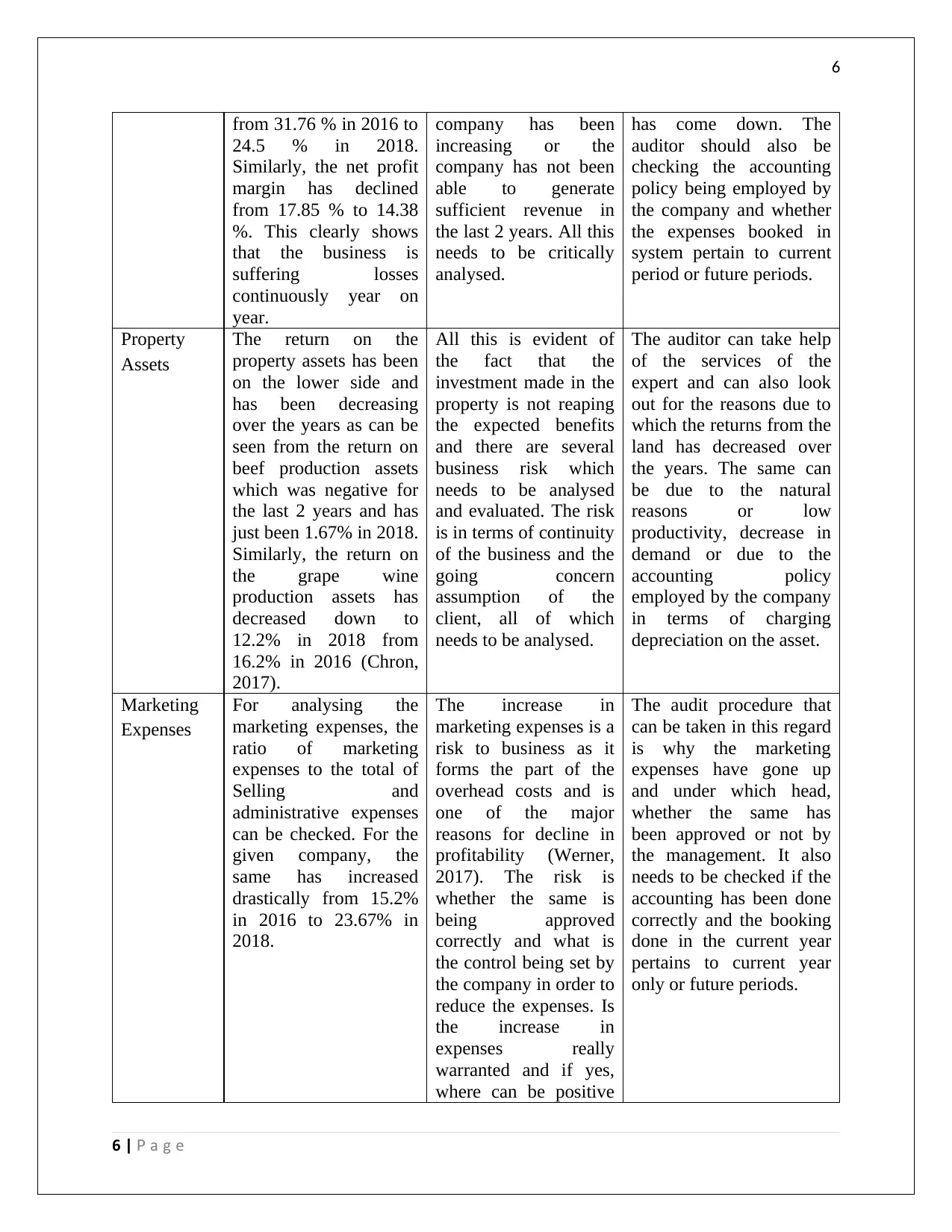
6
from 31.76 % in 2016 to
24.5 % in 2018.
Similarly, the net profit
margin has declined
from 17.85 % to 14.38
%. This clearly shows
that the business is
suffering losses
continuously year on
year.
company has been
increasing or the
company has not been
able to generate
sufficient revenue in
the last 2 years. All this
needs to be critically
analysed.
has come down. The
auditor should also be
checking the accounting
policy being employed by
the company and whether
the expenses booked in
system pertain to current
period or future periods.
Property
Assets
The return on the
property assets has been
on the lower side and
has been decreasing
over the years as can be
seen from the return on
beef production assets
which was negative for
the last 2 years and has
just been 1.67% in 2018.
Similarly, the return on
the grape wine
production assets has
decreased down to
12.2% in 2018 from
16.2% in 2016 (Chron,
2017).
All this is evident of
the fact that the
investment made in the
property is not reaping
the expected benefits
and there are several
business risk which
needs to be analysed
and evaluated. The risk
is in terms of continuity
of the business and the
going concern
assumption of the
client, all of which
needs to be analysed.
The auditor can take help
of the services of the
expert and can also look
out for the reasons due to
which the returns from the
land has decreased over
the years. The same can
be due to the natural
reasons or low
productivity, decrease in
demand or due to the
accounting policy
employed by the company
in terms of charging
depreciation on the asset.
Marketing
Expenses
For analysing the
marketing expenses, the
ratio of marketing
expenses to the total of
Selling and
administrative expenses
can be checked. For the
given company, the
same has increased
drastically from 15.2%
in 2016 to 23.67% in
2018.
The increase in
marketing expenses is a
risk to business as it
forms the part of the
overhead costs and is
one of the major
reasons for decline in
profitability (Werner,
2017). The risk is
whether the same is
being approved
correctly and what is
the control being set by
the company in order to
reduce the expenses. Is
the increase in
expenses really
warranted and if yes,
where can be positive
The audit procedure that
can be taken in this regard
is why the marketing
expenses have gone up
and under which head,
whether the same has
been approved or not by
the management. It also
needs to be checked if the
accounting has been done
correctly and the booking
done in the current year
pertains to current year
only or future periods.
6 | a g eP
from 31.76 % in 2016 to
24.5 % in 2018.
Similarly, the net profit
margin has declined
from 17.85 % to 14.38
%. This clearly shows
that the business is
suffering losses
continuously year on
year.
company has been
increasing or the
company has not been
able to generate
sufficient revenue in
the last 2 years. All this
needs to be critically
analysed.
has come down. The
auditor should also be
checking the accounting
policy being employed by
the company and whether
the expenses booked in
system pertain to current
period or future periods.
Property
Assets
The return on the
property assets has been
on the lower side and
has been decreasing
over the years as can be
seen from the return on
beef production assets
which was negative for
the last 2 years and has
just been 1.67% in 2018.
Similarly, the return on
the grape wine
production assets has
decreased down to
12.2% in 2018 from
16.2% in 2016 (Chron,
2017).
All this is evident of
the fact that the
investment made in the
property is not reaping
the expected benefits
and there are several
business risk which
needs to be analysed
and evaluated. The risk
is in terms of continuity
of the business and the
going concern
assumption of the
client, all of which
needs to be analysed.
The auditor can take help
of the services of the
expert and can also look
out for the reasons due to
which the returns from the
land has decreased over
the years. The same can
be due to the natural
reasons or low
productivity, decrease in
demand or due to the
accounting policy
employed by the company
in terms of charging
depreciation on the asset.
Marketing
Expenses
For analysing the
marketing expenses, the
ratio of marketing
expenses to the total of
Selling and
administrative expenses
can be checked. For the
given company, the
same has increased
drastically from 15.2%
in 2016 to 23.67% in
2018.
The increase in
marketing expenses is a
risk to business as it
forms the part of the
overhead costs and is
one of the major
reasons for decline in
profitability (Werner,
2017). The risk is
whether the same is
being approved
correctly and what is
the control being set by
the company in order to
reduce the expenses. Is
the increase in
expenses really
warranted and if yes,
where can be positive
The audit procedure that
can be taken in this regard
is why the marketing
expenses have gone up
and under which head,
whether the same has
been approved or not by
the management. It also
needs to be checked if the
accounting has been done
correctly and the booking
done in the current year
pertains to current year
only or future periods.
6 | a g eP
Paraphrase This Document
Need a fresh take? Get an instant paraphrase of this document with our AI Paraphraser
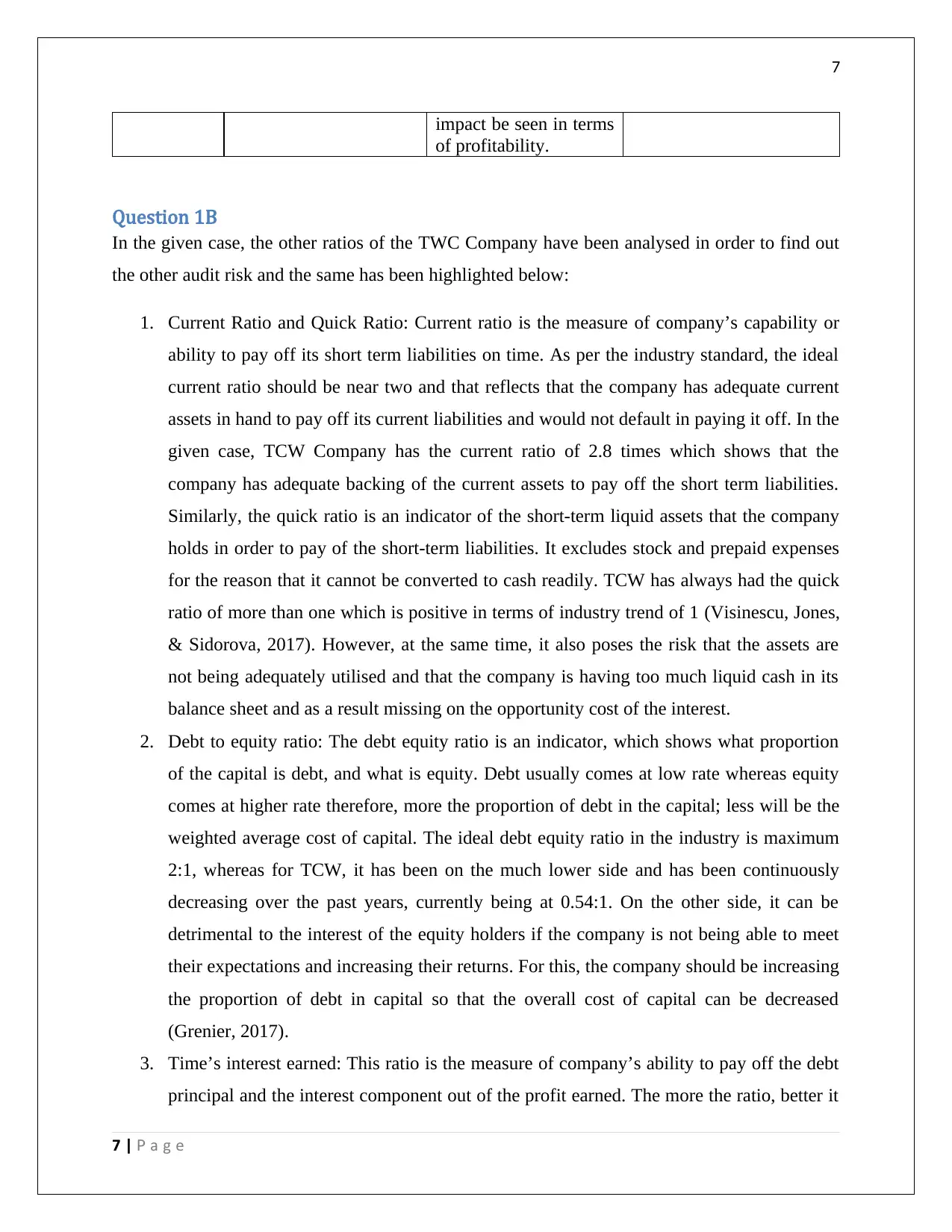
7
impact be seen in terms
of profitability.
Question 1B
In the given case, the other ratios of the TWC Company have been analysed in order to find out
the other audit risk and the same has been highlighted below:
1. Current Ratio and Quick Ratio: Current ratio is the measure of company’s capability or
ability to pay off its short term liabilities on time. As per the industry standard, the ideal
current ratio should be near two and that reflects that the company has adequate current
assets in hand to pay off its current liabilities and would not default in paying it off. In the
given case, TCW Company has the current ratio of 2.8 times which shows that the
company has adequate backing of the current assets to pay off the short term liabilities.
Similarly, the quick ratio is an indicator of the short-term liquid assets that the company
holds in order to pay of the short-term liabilities. It excludes stock and prepaid expenses
for the reason that it cannot be converted to cash readily. TCW has always had the quick
ratio of more than one which is positive in terms of industry trend of 1 (Visinescu, Jones,
& Sidorova, 2017). However, at the same time, it also poses the risk that the assets are
not being adequately utilised and that the company is having too much liquid cash in its
balance sheet and as a result missing on the opportunity cost of the interest.
2. Debt to equity ratio: The debt equity ratio is an indicator, which shows what proportion
of the capital is debt, and what is equity. Debt usually comes at low rate whereas equity
comes at higher rate therefore, more the proportion of debt in the capital; less will be the
weighted average cost of capital. The ideal debt equity ratio in the industry is maximum
2:1, whereas for TCW, it has been on the much lower side and has been continuously
decreasing over the past years, currently being at 0.54:1. On the other side, it can be
detrimental to the interest of the equity holders if the company is not being able to meet
their expectations and increasing their returns. For this, the company should be increasing
the proportion of debt in capital so that the overall cost of capital can be decreased
(Grenier, 2017).
3. Time’s interest earned: This ratio is the measure of company’s ability to pay off the debt
principal and the interest component out of the profit earned. The more the ratio, better it
7 | a g eP
impact be seen in terms
of profitability.
Question 1B
In the given case, the other ratios of the TWC Company have been analysed in order to find out
the other audit risk and the same has been highlighted below:
1. Current Ratio and Quick Ratio: Current ratio is the measure of company’s capability or
ability to pay off its short term liabilities on time. As per the industry standard, the ideal
current ratio should be near two and that reflects that the company has adequate current
assets in hand to pay off its current liabilities and would not default in paying it off. In the
given case, TCW Company has the current ratio of 2.8 times which shows that the
company has adequate backing of the current assets to pay off the short term liabilities.
Similarly, the quick ratio is an indicator of the short-term liquid assets that the company
holds in order to pay of the short-term liabilities. It excludes stock and prepaid expenses
for the reason that it cannot be converted to cash readily. TCW has always had the quick
ratio of more than one which is positive in terms of industry trend of 1 (Visinescu, Jones,
& Sidorova, 2017). However, at the same time, it also poses the risk that the assets are
not being adequately utilised and that the company is having too much liquid cash in its
balance sheet and as a result missing on the opportunity cost of the interest.
2. Debt to equity ratio: The debt equity ratio is an indicator, which shows what proportion
of the capital is debt, and what is equity. Debt usually comes at low rate whereas equity
comes at higher rate therefore, more the proportion of debt in the capital; less will be the
weighted average cost of capital. The ideal debt equity ratio in the industry is maximum
2:1, whereas for TCW, it has been on the much lower side and has been continuously
decreasing over the past years, currently being at 0.54:1. On the other side, it can be
detrimental to the interest of the equity holders if the company is not being able to meet
their expectations and increasing their returns. For this, the company should be increasing
the proportion of debt in capital so that the overall cost of capital can be decreased
(Grenier, 2017).
3. Time’s interest earned: This ratio is the measure of company’s ability to pay off the debt
principal and the interest component out of the profit earned. The more the ratio, better it
7 | a g eP
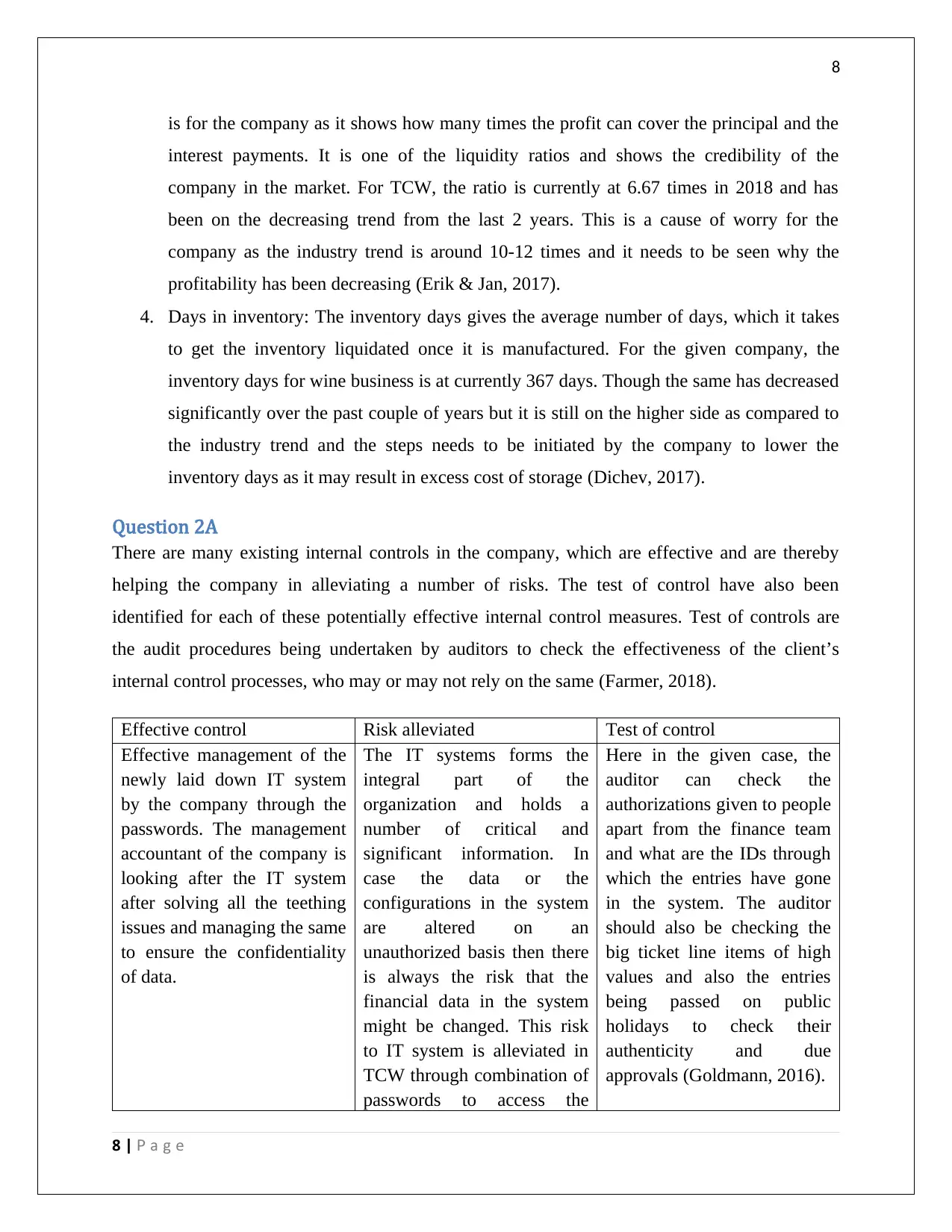
8
is for the company as it shows how many times the profit can cover the principal and the
interest payments. It is one of the liquidity ratios and shows the credibility of the
company in the market. For TCW, the ratio is currently at 6.67 times in 2018 and has
been on the decreasing trend from the last 2 years. This is a cause of worry for the
company as the industry trend is around 10-12 times and it needs to be seen why the
profitability has been decreasing (Erik & Jan, 2017).
4. Days in inventory: The inventory days gives the average number of days, which it takes
to get the inventory liquidated once it is manufactured. For the given company, the
inventory days for wine business is at currently 367 days. Though the same has decreased
significantly over the past couple of years but it is still on the higher side as compared to
the industry trend and the steps needs to be initiated by the company to lower the
inventory days as it may result in excess cost of storage (Dichev, 2017).
Question 2A
There are many existing internal controls in the company, which are effective and are thereby
helping the company in alleviating a number of risks. The test of control have also been
identified for each of these potentially effective internal control measures. Test of controls are
the audit procedures being undertaken by auditors to check the effectiveness of the client’s
internal control processes, who may or may not rely on the same (Farmer, 2018).
Effective control Risk alleviated Test of control
Effective management of the
newly laid down IT system
by the company through the
passwords. The management
accountant of the company is
looking after the IT system
after solving all the teething
issues and managing the same
to ensure the confidentiality
of data.
The IT systems forms the
integral part of the
organization and holds a
number of critical and
significant information. In
case the data or the
configurations in the system
are altered on an
unauthorized basis then there
is always the risk that the
financial data in the system
might be changed. This risk
to IT system is alleviated in
TCW through combination of
passwords to access the
Here in the given case, the
auditor can check the
authorizations given to people
apart from the finance team
and what are the IDs through
which the entries have gone
in the system. The auditor
should also be checking the
big ticket line items of high
values and also the entries
being passed on public
holidays to check their
authenticity and due
approvals (Goldmann, 2016).
8 | a g eP
is for the company as it shows how many times the profit can cover the principal and the
interest payments. It is one of the liquidity ratios and shows the credibility of the
company in the market. For TCW, the ratio is currently at 6.67 times in 2018 and has
been on the decreasing trend from the last 2 years. This is a cause of worry for the
company as the industry trend is around 10-12 times and it needs to be seen why the
profitability has been decreasing (Erik & Jan, 2017).
4. Days in inventory: The inventory days gives the average number of days, which it takes
to get the inventory liquidated once it is manufactured. For the given company, the
inventory days for wine business is at currently 367 days. Though the same has decreased
significantly over the past couple of years but it is still on the higher side as compared to
the industry trend and the steps needs to be initiated by the company to lower the
inventory days as it may result in excess cost of storage (Dichev, 2017).
Question 2A
There are many existing internal controls in the company, which are effective and are thereby
helping the company in alleviating a number of risks. The test of control have also been
identified for each of these potentially effective internal control measures. Test of controls are
the audit procedures being undertaken by auditors to check the effectiveness of the client’s
internal control processes, who may or may not rely on the same (Farmer, 2018).
Effective control Risk alleviated Test of control
Effective management of the
newly laid down IT system
by the company through the
passwords. The management
accountant of the company is
looking after the IT system
after solving all the teething
issues and managing the same
to ensure the confidentiality
of data.
The IT systems forms the
integral part of the
organization and holds a
number of critical and
significant information. In
case the data or the
configurations in the system
are altered on an
unauthorized basis then there
is always the risk that the
financial data in the system
might be changed. This risk
to IT system is alleviated in
TCW through combination of
passwords to access the
Here in the given case, the
auditor can check the
authorizations given to people
apart from the finance team
and what are the IDs through
which the entries have gone
in the system. The auditor
should also be checking the
big ticket line items of high
values and also the entries
being passed on public
holidays to check their
authenticity and due
approvals (Goldmann, 2016).
8 | a g eP
⊘ This is a preview!⊘
Do you want full access?
Subscribe today to unlock all pages.

Trusted by 1+ million students worldwide

9
programs. Only the access is
being given to the database
which does not authorises
anybody to pass financial
entries in the books.
The 2nd internal control
measure which can be said to
be effective is the approval
mechanism set for order
punching. Any order beyond
$ 10000 goes for approval.
The approval matrix being :
$10000-30000: Management
Accountant;
$30000-50000: CEO;
Above $50000: Board of
Directors
This internal control assures
that there would be no
unnecessary ordering of the
goods in the company. The
section managers responsible
for grape, wine and beef
production are only
authorised to order up to $
10000 at one go. This helps
the company in 2 ways,
neither the funds are
unnecessarily blocked, nor
the wrong use of authority is
being taken (Linden &
Freeman, 2017).
To have a check on this
internal control, the auditor
can check all the order
bookings made in the
computer system for the last
couple of months. It should
be checked if all of them
were as per approval matrix
and with necessary approvals.
It also needs to be checked if
the inventory in hand is
excess or normal as required.
The process which is being
maintained in the company
for the receipt of material,
invoice verification, booking
of vendor liability and then
payment post punching the
invoices in the register is an
end to end comprehensive
process for the vendor
booking/purchases and
payments.
This process alleviates the
major risk that the false
invoices are not being
accounted in the system and
that there is no discrepancy in
the quantity of stock as the
register is maintained and
post verification only the
invoices are sent for payment
purposes. In case the invoice
sent by supplier over
electronic means and order
received does not matches,
the same is not paid until due
reconciliation.
This process ensures that
there is segregation of duties
and thus the 4 eye principle is
being followed, the same can
be checked if the order copies
were duly approved and
signed. Sample checking can
also be initiated for the order
copies and invoices if both of
them are matching (Jefferson,
2017).
Question 2B
Besides all the effective internal controls being maintained by the company, it is also suffering
from a number of weaknesses in many areas relating to accounts payable and purchases. Some of
them are highlighted below:
Weaknesses Justification
The supplier information file is being There is no system record for the changes
9 | a g eP
programs. Only the access is
being given to the database
which does not authorises
anybody to pass financial
entries in the books.
The 2nd internal control
measure which can be said to
be effective is the approval
mechanism set for order
punching. Any order beyond
$ 10000 goes for approval.
The approval matrix being :
$10000-30000: Management
Accountant;
$30000-50000: CEO;
Above $50000: Board of
Directors
This internal control assures
that there would be no
unnecessary ordering of the
goods in the company. The
section managers responsible
for grape, wine and beef
production are only
authorised to order up to $
10000 at one go. This helps
the company in 2 ways,
neither the funds are
unnecessarily blocked, nor
the wrong use of authority is
being taken (Linden &
Freeman, 2017).
To have a check on this
internal control, the auditor
can check all the order
bookings made in the
computer system for the last
couple of months. It should
be checked if all of them
were as per approval matrix
and with necessary approvals.
It also needs to be checked if
the inventory in hand is
excess or normal as required.
The process which is being
maintained in the company
for the receipt of material,
invoice verification, booking
of vendor liability and then
payment post punching the
invoices in the register is an
end to end comprehensive
process for the vendor
booking/purchases and
payments.
This process alleviates the
major risk that the false
invoices are not being
accounted in the system and
that there is no discrepancy in
the quantity of stock as the
register is maintained and
post verification only the
invoices are sent for payment
purposes. In case the invoice
sent by supplier over
electronic means and order
received does not matches,
the same is not paid until due
reconciliation.
This process ensures that
there is segregation of duties
and thus the 4 eye principle is
being followed, the same can
be checked if the order copies
were duly approved and
signed. Sample checking can
also be initiated for the order
copies and invoices if both of
them are matching (Jefferson,
2017).
Question 2B
Besides all the effective internal controls being maintained by the company, it is also suffering
from a number of weaknesses in many areas relating to accounts payable and purchases. Some of
them are highlighted below:
Weaknesses Justification
The supplier information file is being There is no system record for the changes
9 | a g eP
Paraphrase This Document
Need a fresh take? Get an instant paraphrase of this document with our AI Paraphraser

10
maintained by the accounts clerk and any
changes which are made in the file is finally
being approved by the management
accountant, i.e., he is the ultimate authority
and custodian for its maintenance and no
record is maintained electronically or
elsewhere as how many times the changes
have been done (Sithole, Chandler,
Abeysekera, & Paas, 2017).
made in the supplier master information and
the process being entirely manual, the
management accountant has the authority to
make the changes anytime post which no
control is being maintained. Thus, there may
be a case when the existing supplier may be
deleted or a new supplier may be added
without proper procedure and the company
would not be aware of the same and therefore
proper internal control is required in this
aspect.
The payment is being made to the vendors
directly by the bank and the ABA file is being
uploaded by the management accountant
himself post he approves the same. There is a
lack of segregation of duty in this case
(Raiborn, Butler, & Martin, 2016).
There is no 4 eye principle which is being
followed here. The management accountant is
the one who is approving the file and then he
is the one who is uploading the file so there
can be a case where he is approving
unauthorised payment or transaction and
uploading the same in bank portal for
payment and nobody would be aware of the
same. This might have a serious financial
impact on the company.
For both the service as well as supplier
invoices, when the same is being approved
and uploaded in the system by the
management accountant, it is assumed to be
paid and marked as paid in the accounting
system without having proper reference no. or
acknowledgement of the same. This can lead
to reconciliation issues with the vendor in the
future.
To avoid the given issue, the company can
always have an acknowledgement number
from the bank for each of the payments and
fix it up in the payments file so that proper
accounting is done and supporting is also
there. Moreover, the balance confirmation
from the dealers as well as customers should
be taken on monthly basis over mails so that
no reconciliation issues are there.
The approval mechanism is working as an
effective internal control but there should be a
maximum limit of stock beyond which even
the section managers should not be allowed to
raise purchase requests. Furthermore, there
should be minimum limit of stock which
when reached only then the new purchase
request should be raised (Kuhn & Morris,
2016).
In case the adjacently mentioned control is
not being implemented in the system, then
any section manager would be able to raise
any request for inventory and there would be
no control on the same, and thereby the
company can end up having excess stock and
paying excess storage costs as well.
10 | a g eP
maintained by the accounts clerk and any
changes which are made in the file is finally
being approved by the management
accountant, i.e., he is the ultimate authority
and custodian for its maintenance and no
record is maintained electronically or
elsewhere as how many times the changes
have been done (Sithole, Chandler,
Abeysekera, & Paas, 2017).
made in the supplier master information and
the process being entirely manual, the
management accountant has the authority to
make the changes anytime post which no
control is being maintained. Thus, there may
be a case when the existing supplier may be
deleted or a new supplier may be added
without proper procedure and the company
would not be aware of the same and therefore
proper internal control is required in this
aspect.
The payment is being made to the vendors
directly by the bank and the ABA file is being
uploaded by the management accountant
himself post he approves the same. There is a
lack of segregation of duty in this case
(Raiborn, Butler, & Martin, 2016).
There is no 4 eye principle which is being
followed here. The management accountant is
the one who is approving the file and then he
is the one who is uploading the file so there
can be a case where he is approving
unauthorised payment or transaction and
uploading the same in bank portal for
payment and nobody would be aware of the
same. This might have a serious financial
impact on the company.
For both the service as well as supplier
invoices, when the same is being approved
and uploaded in the system by the
management accountant, it is assumed to be
paid and marked as paid in the accounting
system without having proper reference no. or
acknowledgement of the same. This can lead
to reconciliation issues with the vendor in the
future.
To avoid the given issue, the company can
always have an acknowledgement number
from the bank for each of the payments and
fix it up in the payments file so that proper
accounting is done and supporting is also
there. Moreover, the balance confirmation
from the dealers as well as customers should
be taken on monthly basis over mails so that
no reconciliation issues are there.
The approval mechanism is working as an
effective internal control but there should be a
maximum limit of stock beyond which even
the section managers should not be allowed to
raise purchase requests. Furthermore, there
should be minimum limit of stock which
when reached only then the new purchase
request should be raised (Kuhn & Morris,
2016).
In case the adjacently mentioned control is
not being implemented in the system, then
any section manager would be able to raise
any request for inventory and there would be
no control on the same, and thereby the
company can end up having excess stock and
paying excess storage costs as well.
10 | a g eP
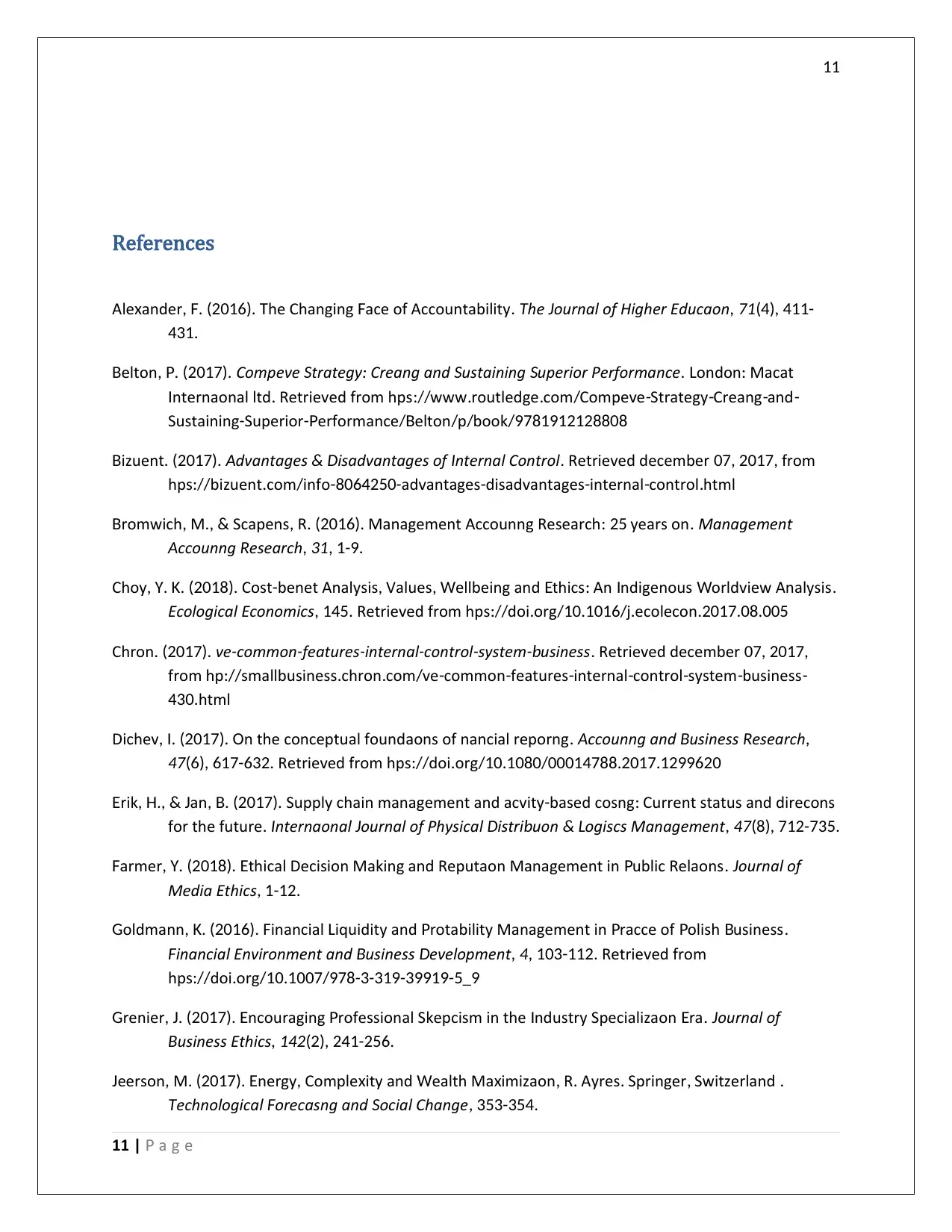
11
References
Ale ander he Changing ace of Accountabilityx , F. (2016). T F . he ournal of Higher EducationT J , 71(4), 411-
431.
eltonB , P. (2017). Competitive trategy Creating and ustaining uperior PerformanceS : S S . ondon MacatL :
nternational ltd Retrieved from https www routledge com Competitive Strategy Creating andI . :// . . / - - - -
Sustaining Superior erformance elton p book- -P /B / / /9781912128808
izfluentB . (2017). dvantages isadvantages of nternal ControlA & D I Retrieved december from. 07, 2017,
https bizfluent com info advantages disadvantages internal control html:// . / -8064250- - - - .
romwich M Scapens R Management Accounting Research years onB , ., & , . (2016). : 25 . Management
ccounting esearchA R , 31, 1-9.
Choy Cost benefit Analysis Values ellbeing and thics An ndigenous orldview Analysis, Y. K. (2018). - , , W E : I W .
Ecological Economics Retrieved from https doi org j ecolecon, 145. :// . /10.1016/ . .2017.08.005
Chron. (2017). fi ve common features internal control system usiness- - - - - -b Retrieved december. 07, 2017,
from http smallbusiness chron com fi ve common features internal control system business:// . . / - - - - - - -
html430.
Dichev n the conceptual foundations of fi nancial reporting, I. (2017). O . ccounting and usiness esearchA B R ,
47 Retrieved from https doi org(6), 617-632. :// . /10.1080/00014788.2017.1299620
rik an Supply chain management and activity based costing Current status and directionsE , H., & J , B. (2017). - :
for the future. nternational ournal of Physical istri ution ogistics ManagementI J D b & L , 47(8), 712-735.
armer thical Decision Making and Reputation Management in ublic RelationsF , Y. (2018). E P . ournal ofJ
Media Ethics, 1-12.
oldmann inancial iquidity and rofitability Management in ractice of olish usinessG , K. (2016). F L P P P B .
inancial Environment and usiness evelopmentF B D , 4 Retrieved from, 103-112.
https doi org:// . /10.1007/978-3-319-39919-5_9
renier ncouraging rofessional Skepticism in the ndustry Specialization raG , J. (2017). E P I E . ournal ofJ
usiness EthicsB , 142(2), 241-256.
efferson M nergy Comple ity and ealth Ma imization R Ayres Springer SwitzerlandJ , . (2017). E , x W x , . . , .
echnological orecasting and ocial ChangeT F S , 353-354.
11 | a g eP
References
Ale ander he Changing ace of Accountabilityx , F. (2016). T F . he ournal of Higher EducationT J , 71(4), 411-
431.
eltonB , P. (2017). Competitive trategy Creating and ustaining uperior PerformanceS : S S . ondon MacatL :
nternational ltd Retrieved from https www routledge com Competitive Strategy Creating andI . :// . . / - - - -
Sustaining Superior erformance elton p book- -P /B / / /9781912128808
izfluentB . (2017). dvantages isadvantages of nternal ControlA & D I Retrieved december from. 07, 2017,
https bizfluent com info advantages disadvantages internal control html:// . / -8064250- - - - .
romwich M Scapens R Management Accounting Research years onB , ., & , . (2016). : 25 . Management
ccounting esearchA R , 31, 1-9.
Choy Cost benefit Analysis Values ellbeing and thics An ndigenous orldview Analysis, Y. K. (2018). - , , W E : I W .
Ecological Economics Retrieved from https doi org j ecolecon, 145. :// . /10.1016/ . .2017.08.005
Chron. (2017). fi ve common features internal control system usiness- - - - - -b Retrieved december. 07, 2017,
from http smallbusiness chron com fi ve common features internal control system business:// . . / - - - - - - -
html430.
Dichev n the conceptual foundations of fi nancial reporting, I. (2017). O . ccounting and usiness esearchA B R ,
47 Retrieved from https doi org(6), 617-632. :// . /10.1080/00014788.2017.1299620
rik an Supply chain management and activity based costing Current status and directionsE , H., & J , B. (2017). - :
for the future. nternational ournal of Physical istri ution ogistics ManagementI J D b & L , 47(8), 712-735.
armer thical Decision Making and Reputation Management in ublic RelationsF , Y. (2018). E P . ournal ofJ
Media Ethics, 1-12.
oldmann inancial iquidity and rofitability Management in ractice of olish usinessG , K. (2016). F L P P P B .
inancial Environment and usiness evelopmentF B D , 4 Retrieved from, 103-112.
https doi org:// . /10.1007/978-3-319-39919-5_9
renier ncouraging rofessional Skepticism in the ndustry Specialization raG , J. (2017). E P I E . ournal ofJ
usiness EthicsB , 142(2), 241-256.
efferson M nergy Comple ity and ealth Ma imization R Ayres Springer SwitzerlandJ , . (2017). E , x W x , . . , .
echnological orecasting and ocial ChangeT F S , 353-354.
11 | a g eP
⊘ This is a preview!⊘
Do you want full access?
Subscribe today to unlock all pages.

Trusted by 1+ million students worldwide
1 out of 13
Related Documents
Your All-in-One AI-Powered Toolkit for Academic Success.
+13062052269
info@desklib.com
Available 24*7 on WhatsApp / Email
![[object Object]](/_next/static/media/star-bottom.7253800d.svg)
Unlock your academic potential
Copyright © 2020–2025 A2Z Services. All Rights Reserved. Developed and managed by ZUCOL.





